Though From Software couldn’t have known it at the time, the release of Demon’s Souls would change the face of gaming forever. It gave birth to an entirely new subgenre of RPG while also redefining the general context of difficulty in games. Deeply layered lore, a mysterious world, and methodical — almost surgical — combat mechanics cemented its place as a multi-generational must-play.
In the years since its release on the PlayStation 3 in 2009, Demon’s Souls has mostly watched from the shadows as its spiritual sequels have basked in the adulation for which it was the foundation. Darks Souls, Bloodborne, and even Sekiro: Shadows Die Twice are all exceptional games rightly lauded for their simultaneous adherence to and iteration of the original formula. Each brings something special and unique to the legacy of the Old One.
But they aren’t the same special concoction that is Demon’s Souls.
Indeed, the return of such an indelible classic on the PlayStation 5 is perhaps more than fans could have ever hoped for. Remastered and enhanced by the expert team at Bluepoint Games (who also gave us Shadow of the Colossus remastered and Metal Gear Solid HD), Demon’s Souls is a veritable triumph of execution and a stunning showcase for Sony’s newest console.
Demon’s Souls Review — Key to Life’s Ether
To be clear: Demon’s Souls on PS5 is a remaster with many breathtaking next-gen (now current-gen) enhancements. It is not a full-on remake. That, however, does not compromise what Bluepoint Games has accomplished or render it any less majestic.
The underlying code of the game remains intact, meaning that most of the gears that made the original Demon’s Souls work so well are still hard at work in the remaster — they’ve just been greased and oiled with the power of the PlayStation 5.
Combat, then, is mostly the same. It’s still tough as nails and predicated on methodical, patient play, where each enemy commands both respect and strategy to defeat. Take an enemy for granted at nearly any level, and you’ll quickly learn the definitions of pain and punishment. Late-game foes, even if they resemble those from earlier levels, can be utterly unforgiving.
Movement is a tad less janky than it is in the PlayStation 3 version. It feels noticeably less floaty and more substantial from the start, even if it sometimes finds ways to act up when rolling or treading carefully along a beam above a bottomless abyss.
Some of this “improvement” can be chalked up to the relative heaviness of the DualSense over the flimsiness of the DualShock 3, but I like to think that the development team has done some alchemy here to strike a balance between old and new.

The charm and personality of From Software’s original vision shines through brightly here.
As with combat, bosses mostly stay true to their original iterations. Tower Knight still lumbers around its arena trying to crush you with its gigantic shield, stomp you with its boots, skewer you with its spear, or hit you with a (sometimes) devastating Soul Arrow. Adjudicator still lashes you with its tongue while punishing slow, inattentive movement. And Old Monk still underscores the inventiveness of the game’s multiplayer system, summoning real players to act as the boss for Tower of Latria’s final level.
Worlds and level layout are virtually unchanged, as well. Enemies, items, and secrets are in the same places they were before. If you’ve played the original, you already know where everything is and how everything operates. But I, like many other Souls fans, wouldn’t have it any other way.
It’s like revisiting an old friend that’s grown wiser in the decades since youth, but one that remains familiar and approachable. The charm and personality of From Software’s original vision shines through brightly here, and for that, Bluepoint deserves everlasting praise.

Though many parts of Demon’s Souls still feel like Demon’s Souls, the remaster is the best version of the game because of the tweaks and changes Bluepoint has implemented from beginning to end. The most obvious of these, of course, is the dramatic graphical overhaul showcased in all of the trailers and screenshots leading up to release.
It’s to be expected DeS would look better on the PS5 than it does on the PS3, but it cannot be overstated how impossibly gorgeous this game is. There are two display modes available: Cinematic mode, which runs at 4K but a lower, choppier framerate, and Performance mode, which runs at a variable resolution but stays at a solid 60fps.
Not only does Demon’s Souls feel fantastic in Performance mode, but it also still looks fantastic, underscoring the fact that sacrificing frames for visuals in Cinematic mode just isn’t worth it. All of the game’s environments, from the ramparts of Boletarian Palace to the depths of the Valley of Defilement, are so incredibly detailed and refined in this mode that it’s the most definitive and enjoyable way to play the game.
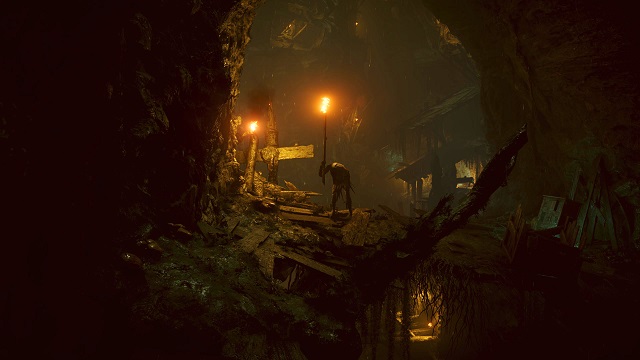
Instead of relying solely on monochromatic color patterns as in the original, DeS remastered now intersperses worlds and levels with more diverse swatches of color that better realize the land of Boletaria. Though most environments are still rooted in darker browns and greens, there’s much more vibrancy and contrast to each location by way of expert lighting and other environmental effects just not possible on the PlayStation 3.
Torches twinkle in the dark of Stonefang Tunnel and the Valley of Defilement, casting looming shadows along the walls and decrepit buildings. Water puddles ripple as you splash through them, sending droplets flying in multiple directions each time. Banners flutter in the wind, twisting and turning in each gust. Lightning cracks through the sky in twisting arcs that ignites rolling clouds.
Walls, cliffs, boards, and doors have incredible texture, and geometric enhancements mean that certain surfaces are no longer flat or amorphous, allowing bricks and other architectural flourishes — such as the meticulous detailing on each Archstone — to jut outward or curve around exteriors realistically. Rocks pepper the ground in Stonefang Tunnel, making it feel more like an actual mine. Cracks and fissures in Boletarian Palace make it feel more run down and abandoned.
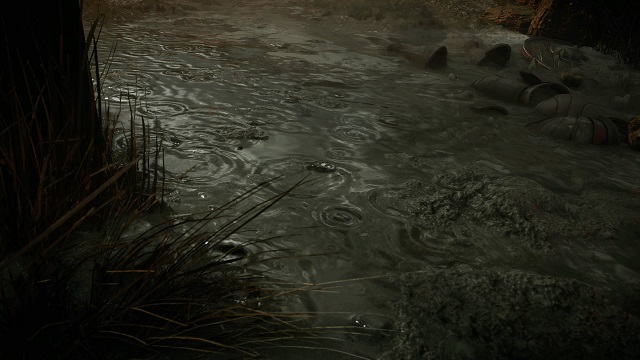
This attention to detail carries over to character models, as well. Boletarian soldiers grimace in agony when attacked. The tongues of Depraved Ones droop from their mouths and flop about as they attack you. Mindflayers snake their tentacles toward you to drain your lifeforce in a terrifying waking nightmare.
In a nice touch, blood and mud now stick to your character, while the aura of soulform has graduated from a pittling glow to a detailed “steam” that rises from your character’s upper body and head.
At this point, it’s worth mention the improved character creation system. Bluepoint claims there are “16 million permutations” available in Demon’s Souls remastered, and while I only have two characters at the moment and I certainly haven’t spent hours and hours confirming there are truly that many options, what is on offer adds tremendous credence to the claim.
Options for body type and appearance are greatly expanded upon from the original, with 48 presets to choose from and myriad sliders to adjust everything from brow depth and nose height to facial hair (beards!), skin color, and tattoos.
Creating the perfect character isn’t a useless endeavor, either. There’s now an option in the primary menu that allows you to remove your headgear during play, and the in-game facial rendering means you can see every last detail of your meticulously created you. And yes, the incredibly awkward but timelessly chic friar cut makes a triumphant return.
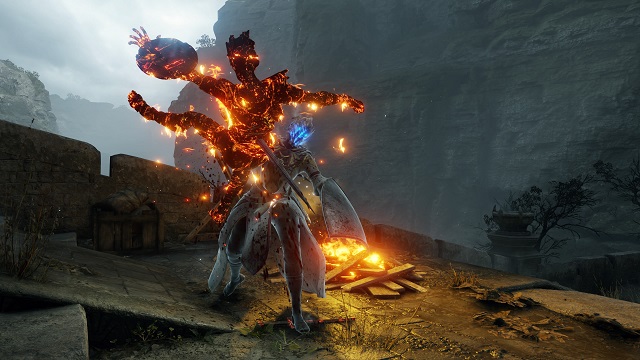
The little details add up to show the amount of love poured into each and every aspect of this new Demon’s Souls experience.
Bluepoint has also added a plethora of new animations to the mix for attacks, parries, and backstabs. Each weapon, even those in the same class, can have different animations; only a handful of swords, axes, and spears operate the same visually. The heavy attack for the Great Axe and Guillotine Axe, for example, is similar but subtly different, lending to each a distinctive feeling.
Backstabs vary from enemy to enemy, as well as if you’re holding your weapon with two hands. Kicking a Blue Eye Knight off the end of your longsword is a powerful sensation and never gets old. Parries, on the other hand, which I’m terrible at, are effectively brutal, lending a sense of heft and energy to the move found in few other places.
Performing a parry with a long sword or crescent falchion jabs the blade through an enemy before you lift them and slam them down. With the dagger, you stab an enemy multiple times before slashing through their neck. Weirdly, the great axe includes a stabbing animation, which sees you ramming the blunt end of the weapon straight through an enemy. Ouch.
Spells aren’t left out in the cold. Soul Arrow, for example, uses a shoving animation, while Soul Ray has an animation that resembles underhanding a baseball. Warding is a singular circular motion, while Protection uses two circular motions.
These little details may not seem immediately consequential, but they add up to show the amount of love poured into each and every aspect of this new Demon’s Souls experience.
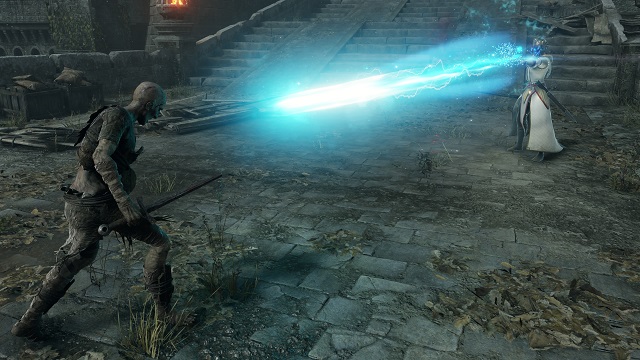
Attached to this is how the game implements the haptics and rumble features of the DualSense controller. Whacking a sword against stone creates a strong pulse from the middle of the controller that centers in your palm. Striking the tip of the same sword along a stone wall creates a smaller pulse that diffuses more evenly across your entire hand.
Soul Arrow rumbles through the controller as a small wave from the center outward, while Soul Ray does the same, just with an added punch at the end after a slight pause.
Like the archery sections of Astro’s Playroom, Demon’s Souls also uses tension in the triggers when using a bow. The initial bump feels a lot like nocking an arrow and pulling it back against a tense bowstring. I noticed that the tension isn’t the same every time, as it’s often strongest when you first nock an arrow after not doing so for a few minutes.
It’s unfortunate that the rest of the game doesn’t make good use of the adaptive triggers. There’s no tactile power in parrying, and heavy attacks feel just as they would on a DualShock 4. Though, to be fair, having feedback in every swing and thrust would likely get grating quickly, not to mention wear out the triggers prematurely.
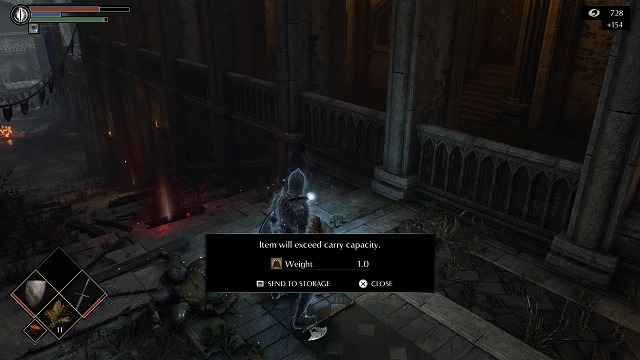
Perhaps some of the most welcome improvements to this version of Demon’s Souls come in the form of quality of life changes. These add to the overall experience without toying with the core mechanics detrimentally.
You can now send items from your inventory, or those in the world that would over encumber you, to Stockpile Thomas at the click of a button. This is incredibly helpful for transferring shards and stones while farming or for picking up unique weapons and armor you just don’t want to come back to.
Weapon and shield durability is smartly shown as a red bar next to your currently equipped items in the lower-left portion of the screen, cutting down on time spent in menus. There’s also a hotkey toolbelt system that expands your ability to use items quickly in the heat of a fight in case you’ve forgotten to save them to your items list (just don’t forget to set them in the toolbelt, either!).
World and Character Tendency, the system by which your in-game actions are judged, is much easier to discern in the remaster, getting its own menu divided into the two categories. This is important for those seeking out certain NPCs and for knowing whether or not specific level areas have opened or remain blocked off. Being able to see changes in this system every time you return to the Nexus in an easy to access menu is leagues better than the nebulousness of the original approach.
You can now also warp between Archstones within worlds and from world to world, similar to the bonfire system in Dark Souls. Loading times may be lightning fast with the PS5’s SSD, but being able to skip the Nexus when you want to travel between areas is a very welcome addition.
In no small way is the original sound design refined in this version, made more potent by the use of 3D audio…
I’d be remiss if I didn’t spend some time talking about the strength of the remaster’s sound design and soundtrack, both of which pay respectful homage to the score and sounds of 2009’s version of the game. Silence still plays a key role in bolstering the sense of isolation and creeping dread in key areas, but the remaster’s orchestration adds new textural nuance to places like the Prison of Hope and bosses like Flamelurker.
Shunsuke Kida’s original score is legendary in the Souls community for good reason. It’s unique, foreboding, and powerful in ways that few soundtracks are. I wish more of it had been salvaged and made available in the remaster, but I also appreciate the evolution of the score here, which takes Kida’s themes and creates a wider soundscape that is truly epic in its own right.
The game’s sound effects also deserve special mention. You can differentiate between water dripping on stone and steel; boards creak and groan under your feet; armor clinks with little taps as you walk; and soldiers belt out blood-curdling screams when set on fire.
In no small way is the original sound design refined in this version, made more potent by the use of 3D audio, which lets you hear where your enemies are and fathom the full might of a dragon as it flies overhead, the defining swoosh of its wings engulfing your senses.
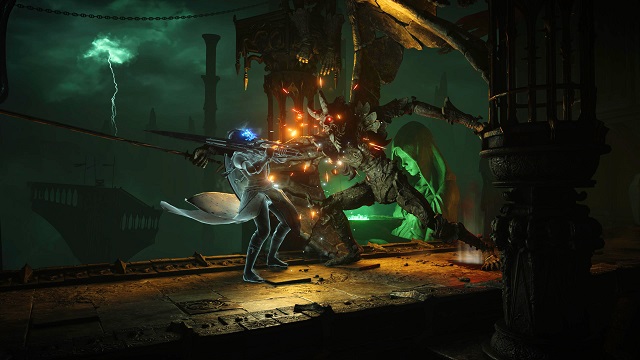
Demon’s Souls isn’t perfect. Because it’s more remaster than remake, some of the original’s more vexing elements have made the transition.
Rubber-banding is still an issue from time to time, especially when fighting more aggressive bosses such as Maneater and Flamelurker. The camera, too, has an annoying tendency to whip around in certain portions of Upper Latria when Gargoyles descend their perches or drop down to catch you on staircases.
Enemies can still clip through walls when using certain attacks, something especially obvious with the SIlver Skeletons in Shrine of Storms, and switching targets while locked on to an enemy doesn’t always choose the one closest to you.
Summoning can still be a drag, even if it’s improved and now employs a password system similar to the one found in Bloodborne. I appreciate its tenacious adherence to the old ways — objectively making it endearing — but I can’t help but wish for something less obtuse and protracted.
All of these would have been nice fixes for Bluepoint to address, if for nothing more than mitigating unnecessary frustration.
Demon’s Souls Review — The Bottom Line
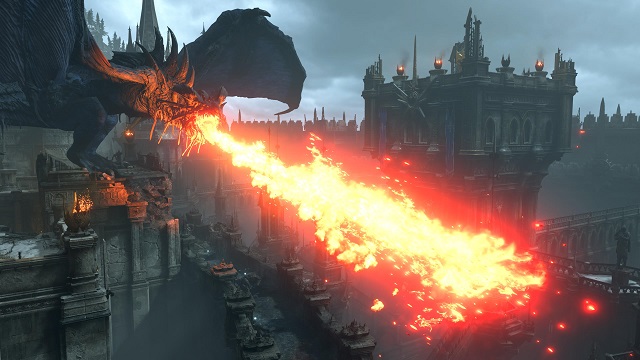
Pros
- Stunning graphics
- Amazing sound design and soundtrack
- Silky smooth Performance mode
- Lightning-fast load times
- Ability to transfer items to stash
- Smart warping system
- Clearer World Tendency indicators
- Omni-directional rolling
- Multiplayer password system
- Robust character creation tool
- Photo mode
Cons
- Lock-on system can be fickle
- Camera can get stuck in places
- Some janky movement and combat
- Choppy Cinematic mode
- Flavorless HP, MP, and Stamina bars
Demon’s Souls is a masterpiece. From jaw-dropping graphics that showcase the pure power of the PlayStation 5 and a sweeping soundscape that takes full advantage of 3D audio, this is a launch title to die for. Add to that a loving and tender adherence to the source material and intelligent quality of life enhancements that make for a more enjoyable experience, and Demon’s Souls on PS5 is perhaps the most complete remaster to ever exist.
I do have small qualms with the underlying code that I wish had been addressed, and it would have been nice for Bluepoint to give the status bars a bit more character. It’s a shame, too, that the Cinematic 4K mode is so unbearably choppy that it’s rendered nearly unplayable once you experience the silky smooth framerates of Performance mode.
Regardless of those relatively small shortcomings, this remaster stands as a shining example of how transformative reimaginings can be, and how, with loving dedication, a remaster can be just as revolutionary and memorable as its source material.
[Note: Sony Interactive Entertainment provided the copy of Demon’s Souls used for this review.]

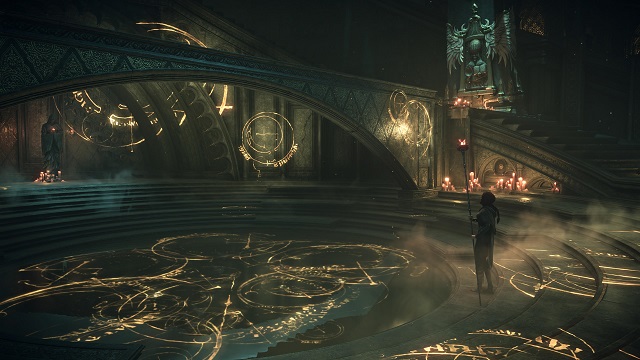





Published: Nov 23, 2020 02:43 pm